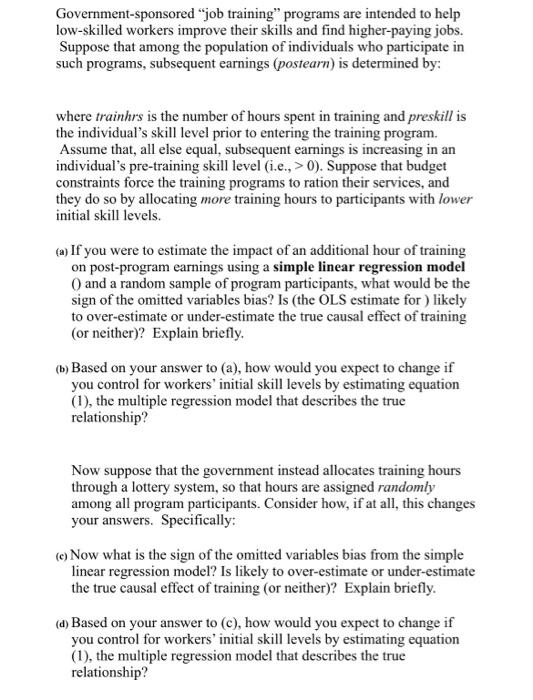Government-sponsored "job training" programs are intended to help low-skilled workers improve their skills and find higher-paying jobs. Suppose that among the population of individuals who participate in such programs, subsequent earnings (postearn) is determined by: where trainhrs is the number of hours spent in training and preskill is the individual's skill level prior to entering the training program. Assume that, all else equal, subsequent earnings is increasing in an individual's pre-training skill level (i.e., >0 ). Suppose that budget constraints force the training programs to ration their services, and they do so by allocating more training hours to participants with lower initial skill levels. (a) If you were to estimate the impact of an additional hour of training on post-program earnings using a simple linear regression model 0 and a random sample of program participants, what would be the sign of the omitted variables bias? Is (the OLS estimate for ) likely to over-estimate or under-estimate the true causal effect of training (or neither)? Explain briefly. (b) Based on your answer to (a), how would you expect to change if you control for workers' initial skill levels by estimating equation (1), the multiple regression model that describes the true relationship? Now suppose that the government instead allocates training hours through a lottery system, so that hours are assigned randomly among all program participants. Consider how, if at all, this changes your answers. Specifically: (c) Now what is the sign of the omitted variables bias from the simple linear regression model? Is likely to over-estimate or under-estimate the true causal effect of training (or neither)? Explain briefly. (d) Based on your answer to (c), how would you expect to change if you control for workers' initial skill levels by estimating equation (1), the multiple regression model that describes the true relationship? Government-sponsored "job training" programs are intended to help low-skilled workers improve their skills and find higher-paying jobs. Suppose that among the population of individuals who participate in such programs, subsequent earnings (postearn) is determined by: where trainhrs is the number of hours spent in training and preskill is the individual's skill level prior to entering the training program. Assume that, all else equal, subsequent earnings is increasing in an individual's pre-training skill level (i.e., >0 ). Suppose that budget constraints force the training programs to ration their services, and they do so by allocating more training hours to participants with lower initial skill levels. (a) If you were to estimate the impact of an additional hour of training on post-program earnings using a simple linear regression model 0 and a random sample of program participants, what would be the sign of the omitted variables bias? Is (the OLS estimate for ) likely to over-estimate or under-estimate the true causal effect of training (or neither)? Explain briefly. (b) Based on your answer to (a), how would you expect to change if you control for workers' initial skill levels by estimating equation (1), the multiple regression model that describes the true relationship? Now suppose that the government instead allocates training hours through a lottery system, so that hours are assigned randomly among all program participants. Consider how, if at all, this changes your answers. Specifically: (c) Now what is the sign of the omitted variables bias from the simple linear regression model? Is likely to over-estimate or under-estimate the true causal effect of training (or neither)? Explain briefly. (d) Based on your answer to (c), how would you expect to change if you control for workers' initial skill levels by estimating equation (1), the multiple regression model that describes the true relationship







